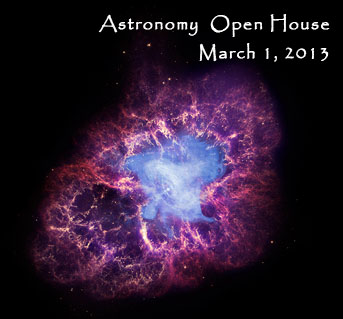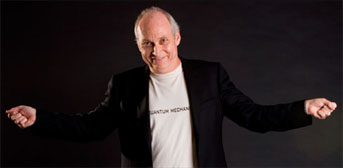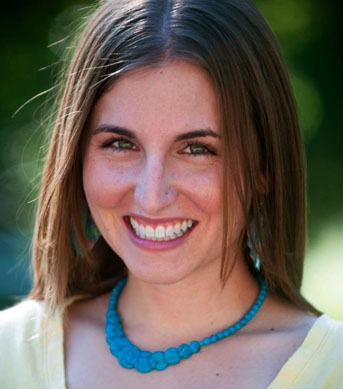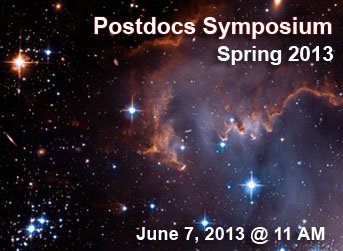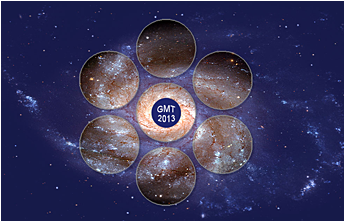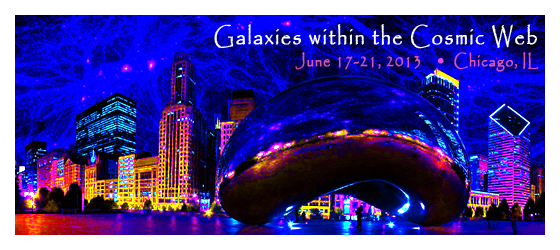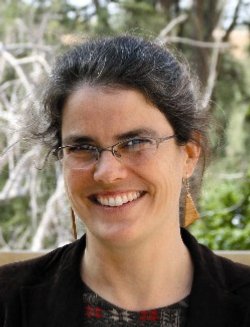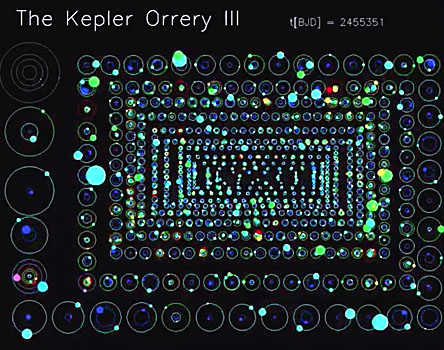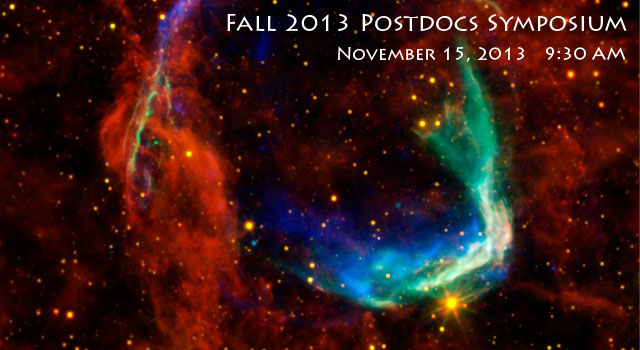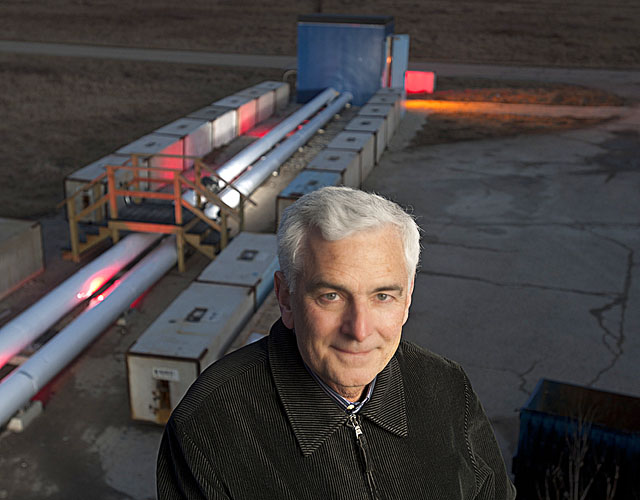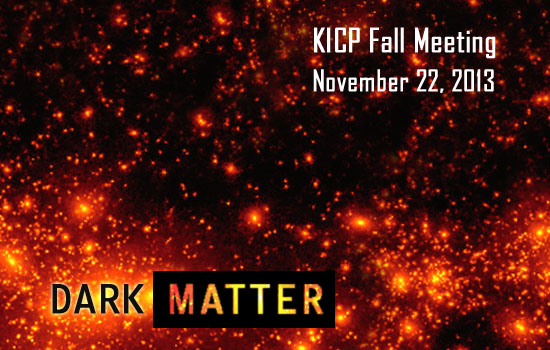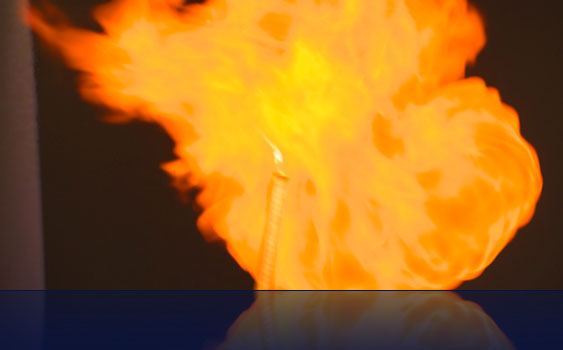 |
 |
 |
 |
 |
 |
 |
 |
 |
 |
 |
 |
|
Talks & Events
|
Workshops & Events: 2013 The Artful Universe with cosmologist Michael S. Turner The Arts|Science Initiative will host a free lecture and discussion on why images of the universe - spacescapes - are so beautiful, at 7 pm Feb 5 in the performance hall of the Reva and David Logan Center for the Arts. The guest speaker will be the University of Chicago's Michael S. Turner, a theoretical physicist and cosmologist who coined the term "dark energy". The audience will travel through space and time with Turner to explore the age of the universe, black holes in galaxies, the birth of stars, and most significantly the mystery of dark energy, whose repulsive gravity is causing the expansion of the universe to accelerate, through the extraordinarily artful visualizations with images produced by the Hubble Space Telescope and other telescopes.. Turner is the Bruce V. and Diana M. Rauner Distinguished Service Professor in Astronomy & Astrophysics and director of the Kavli Institute for Cosmological Physics. He helped establish the interdisciplinary field that combines cosmology and elementary particle physics to understand the origin and evolution of the universe. His research focuses on the earliest moments of creation, and he has made contributions to inflationary cosmology, particle dark matter and structure formation, the theory of big bang nucleosynthesis, and the nature of dark energy. Astronomy Open House 9:00 - 10:30 am Welcome and Presentation: Speakers Profs. Olinto (welcome), Hu, Bean, Gladders LASR conference room 10:30 - 12:00 pm Meetings 12:00 - 1:30 pm KICP Lunch Seminar: speaker Ann Zabludoff, University of Arizon/Steward Observatory, LASR lounge (lunch will be provided) 1:30 - 2:00 pm Outreach Presentation w/ Randy Landsberg, TAAC 67 2:00 - 4:00 pm Meetings 4:00 - 5:00 pm Graduate Student Panel Discussion, TAAC 67 5:00 - 6:00 pm Wine and Cheese Reception, Kitchen/Library 8:00 pm Maggiano's Little Italy Please note that you are all invited to the Wine and Cheese Reception which begins at 5:00 pm. Winter 2013 Postdocs Symposium This quarter's Postdoc Symposium will be on March 15, 9:30AM-12PM. The program:
Lunch, followed by Friday noon seminar (Megan Eckart) Interview with John Carlstrom, "Witnessing Starbursts in the Early Universe" Website On Friday March 29, 12:00-12:30pm PDT, science writer Bruce Lieberman will ask your questions about the starbursts and the early universe with members of the research team: John E. Carlstrom, Dan P. Marrone and Joaquin D. Vieira. Ryerson Lecture: Michael S. Turner, "Quarks and the Cosmos" You are cordially invited to attend The Nora and Edward Ryerson Lecture on Wednesday, April 17, 2013, given by Professor Michael S. Turner. Lecture: "Quarks and the Cosmos" A lecture to be given by Michael S. Turner, the Bruce V. & Diana M. Rauner Distinguished Service Professor, and Director of the Kavli Institute for Cosmological Physics. Wednesday, April 17, 2013 Ida Noyes Hall, 1212 East 59th Street * Lecture: Max Palevsky Cinema at 5:00 p.m. * Reception: Library/Lounge at 6:00 p.m. Lecture and Reception are free and open to the public. Workshop: "Imaging the Extreme Universe: Solid-state cameras for Astroparticle Physics" Website The Kavli Institute for Cosmological Physics (KICP) at the University of Chicago will host a two-day workshop focusing on solid-state technologies to build cameras for both space and ground-based astroparticle physics experiments. In particular, alternatives to MAPMTs for the JEM-EUSO focal plane and CTA cameras will be discussed including SiPM and G-APD. The workshop will be structured as a series of presentations with ample time for discussions and working sessions. Broader Horizons: Maria Cruz, Editor at Science Broader Horizons talk by visitor Maria Cruz discussing her career as an editor at the journal Science. "I realized that I really love science but not spending my time just focusing on a particular aspect of it." --Maria Cruz Broader Horizons: Jessica Kirkpatrick, data scientist / analyst for the social network Yammer Jessica Kirkpatrick received her PhD in Astrophysics from Berkeley in 2012. After an exhaustive job search within academia and beyond, she accepted a job as a data scientist / analyst for the social network Yammer (acquired by Microsoft). Now instead of spending her days finding patterns in the large scale structure of galaxies, she finds patterns in the behaviors of people. She'll talk about her transition from physics to tech, compare and contrast the two fields, and give tips about how to land a tech job. Spring 2013 Postdocs Symposium This quarter's Postdoc Symposium will be on June 7 at 11 AM. The program:
First Annual GMT Community Science Meeting: "Cosmology in the Era of Extremely Large Telescopes" Website The Kavli Institute for Cosmological Physics (KICP) at the University of Chicago and GMTO are planning a joint workshop to be held in Chicago on June 10-12, 2013. The goal of the conference is to examine the role of galaxies as probes of cosmology, both today and in the future as large galaxy surveys and the next generation of large telescopes, in space and on the ground, come into being. We will bring together theorists and observers to discuss contemporary problems in cosmology and galaxy evolution as well as the opportunities offered by a new generation of facilities and surveys. The conference will be organized into five half-day sessions. Keynote speakers will provide an overview of the state of theory and observation in each subfield. Contributed lectures will delve into the details of front-line research issues. The first session will review relevant surveys and facilities, including the GMT, large imaging surveys such as the Dark Energy Survey, LSST, and Euclid among others, and upcoming missions, such as the James Webb Space Telescope. This will be followed by sessions on First-Light and Reionization of the Universe, Galaxy Formation and Assembly, Intergalactic and Circumgalactic Gas, and Galaxies & the Intergalactic medium as probes of Dark Matter and Dark Energy. The conference will be held in downtown Chicago at the University of Chicago's Gleacher Center. A gala conference banquet will be held at the Adler Planetarium looking out on to Lake Michigan. Workshop: "Galaxies within the Cosmic Web" Website The Kavli Institute for Cosmological Physics (KICP) at the University of Chicago will host "Galaxies within the Cosmic Web" workshop on June 17-21, 2013. The workshop will be held in the lecture hall 120 in the Kersten Physics Teaching Center (KPTC) on the University of Chicago campus. During the last thirty years, studies of structure formation have played a key role in establishing the Cold Dark Matter (CDM) paradigm of structure formation in an expanding universe. In the CDM model the initial Gaussian density perturbations are shaped by gravity into a cosmic web of voids and filaments, at the intersection of which galaxies and galaxy clusters are mainly thought to form. Although the model has been a tremendous success in explaining the observed large-scale structure of the universe, many key aspects of how galaxies form and evolve within this cosmic web of dark matter and diffuse gas are still not understood. The gaps in our understanding not only hamper interpretation of the wealth of observational data on galaxy evolution, but also represent a major systematic uncertainty for cosmological probes of the accelerated expansion of the universe, the nature of gravity, and forecasts and interpretation of direct and indirect dark matter searches. This workshop will assemble both observers and theorists (target size ~60-80 people) who work on all key aspects of galaxy formation to assess recent progress and, most importantly, to germinate new ideas for how to improve our understanding of galaxy formation, the relation between the baryonic mass of galaxies and their parent halos, the effects of galaxy assembly and associated feedback on the spatial distribution of dark matter, and the interpretation of galaxy clustering and bias from large surveys to constrain the evolution of dark energy. The focus of the meeting will be on the most rapidly developing and interesting topics of research, and the format will include ample time for discussion and unstructured interaction. 2013 CARMA Science Symposium Website The Kavli Institute for Cosmological Physics (KICP) at the University of Chicago will host the 2013 CARMA Science Symposium on July 8-9, 2013. The two-day meeting will feature presentations relevant to the wide range of interdisciplinary science pursued with CARMA. In particular, there will be presentations from the community on potential future directions for CARMA-related research. These presentations include potential collaboration with new observatories, and science for which CARMA is uniquely suited. Contributions from outside CARMA member institutions are welcome. Graduate students and postdocs are encouraged to submit a presentation. KICP Summer School: Computational Cosmology Website The Kavli Institute for Cosmological Physics (KICP) at the University of Chicago will host a Summer School on Computational Cosmology from August 5 to August 16, 2013. The aim of the School is to expose a select group of 15 to 20 graduate students to the challenges of modern high-performance computing in cosmological research. During the school the emphasis will be on specific hands-on projects designed to teach modern cosmological simulation techniques. The course will also inform students regarding current challenges in the era of petascale supercomputing, and near future challenges, as computation transitions from the petascale to the exascale within the next decade. Orientation discussion sessions on ongoing projects and/or a brief lecture in the morning of each day will be followed by work on individual research projects under the guidance and supervision of school instructors and assistants. The projects will be designed to teach students to set up and run modern N-body and associated analyses (halo finding, visualization, MCMC calculations). Computational work will be carried out on the University of Chicago midway cluster and on development racks of the Blue Gene Q Mira supercomputer at Argonne National Laboratory (ANL). The School will be held in the Laboratory for Astrophysics and Space Research (LASR) at the Kavli Institute for Cosmological Physics. Students will spend the last 2-3 days of the school at Argonne National Laboratory, where they will be introduced to the Argonne Leadership Computing Facility and the Exascale Technology and Computing Institute and will have a chance to implement visualizations of the data based on their school project at the ALCF visualization lab. Workshop "Dark Matter at the LHC" Website KICP is hosting a workshop "Dark Matter at the LHC" this fall on the University of Chicago campus. The workshop will include both theorists and experimentalists actively working on LHC signals of dark matter. The focus will be on model independent approaches. Some topics we plan to cover are monojet, monophoton, and related searches, and improvements in theoretical predictions and experimental techniques. The goal of the meeting is to discuss avenues for taking full advantage of the next LHC run for dark matter studies. This includes exploring new signals of DM models that may be challenging for direct detection or indirect detection experiments, as well as more sophisticated calculations and analyses to improve existing searches. Topics: * Monojet searches for dark matter * Mono-photon, mono-Z, mono-b, and other signatures * Effective field theory constraints * Theoretical improvements in calculations Scientific Writing Workshop: "Structuring your Scientific Paper" Website Papers are central to the work of researchers. Well-designed, they efficiently allow each reader to learn only what he or she needs to. Poorly designed, by contrast, they confuse readers, fail to prompt decisions, or remain unread. Based on Jean-luc Doumont's book Trees, maps, and theorems about "effective communication for rational minds," the session shows how to structure scientific papers, theses, and technical reports effectively at all levels to get the readers' attention, facilitate navigation, and, in this way, get the message across. Practically, the session proceeds as a group discussion, on the basis of sample papers sent by the participants ahead of time. This highly interactive approach builds on the participants' previous experience (as authors or as readers), self-adapts to their current level, accommodates non-homogeneous groups, and makes for an engaging and pleasant learning experience. The use of the participants' own examples ensures a relevant discussion and facilitates the transfer of what they have learned to their writing after the session. About the instructor An engineer from the Louvain School of Engineering and PhD in applied physics from Stanford University, Jean-luc Doumont now devotes his time and energy to training engineers, scientists, business people, and other rational minds in effective communication, pedagogy, statistical thinking, and related themes. Articulate, entertaining, and thought-provoking, Doumont is a popular invited instructor worldwide, in particular at international scientific conferences, research laboratories, and research universities. For additional information, visit www.principiae.be. Astronomy & Astrophysics Department autumn reception The Astronomy & Astrophysics Department autumn quarter welcome reception will be held on Wed. Oct. 2 from 5-7 pm in the Kersten lounge, KPTC 206. Please mark your calendars. Department members, students and their families are welcome to attend. 2013 Brinson Lecture: Andrea M. Ghez, "The Monster at the Heart of the Milky Way" Website Andrea M. Ghez, 2013 Brinson Lecturer Andrea M. Ghez, a professor of Physics & Astronomy who holds the Lauren B. Leichtman & Arthur E. Levine chair in Astrophysics, is one of the world's leading experts in observational astrophysics and heads UCLA's Galactic Center Group. She earned her B.S in Physics from MIT in 1987, and her PhD from Caltech in 1992 and has been on the faculty at UCLA since 1994. Best known for her ground-breaking work on the center of our Galaxy, which has led to the best evidence to date for the existence of supermassive black holes, she has received numerous honors and awards including the Crafoord Prize in Astronomy (she is the first woman to receive a Crafoord prize in any field), a MacArthur Fellowship, and election to the National Academy of Sciences, the American Academy of Arts & Sciences, and the American Philosophical Society. Her work can be found in many public outlets including TED, NOVA's Monster of the Milky Way, Discovery's Swallowed by a Black Hole, and Griffith Observatory. For more information see the UCLA Galactic Center Group website. 2013 Brinson Lecture: "The Monster at the Heart of the Milky Way" Discover how Andrea Ghez and her team use the world's most powerful telescopes and next-generation imaging technology to peer into the center of our galaxy with more resolving power than ever before. By studying the motions of stars, Professor Ghez provides the best evidence that supermassive black holes exist, challenging our knowledge of fundamental physics and suggesting that most, if not all, galaxies harbor such objects at their cores. Her work has also shown that the environment near a central supermassive black hole looks nothing like what was expected. In the near future, she hopes to test Einstein's theory of relativity, as well as theories of galaxy formation and evolution confronting time-honored hypotheses. This event is co-sponsored by the University of Chicago and the School of the Art Institute of Chicago. Physics colloquium: Daniel Hooper, "Dark Matter Annihilation in the Gamma-Ray Sky" If the dark matter is made up of WIMPs, then such particles are expected to annihilate, generating a potentially observable flux of gamma-rays, cosmic rays, and neutrinos. Experiments such as the Fermi Gamma-Ray Space Telescope are designed to search for such annihilation products, and are sensitive to many well motivated dark matter models. I will discuss and review a number of ongoing searches for dark matter using data from Fermi, including searches for gamma-rays from dwarf galaxies, subhalos, galaxy clusters, and the Galactic Center. The central region of the Milky Way is particularly exciting in this context, exhibiting a gamma-ray spectrum and morphology that is consistent with expectations from annihilating dark matter, and difficult to account for with known astrophysical sources or mechanisms. Mini-workshop: Exoplanets after Kepler This Monday (Nov. 11) we'll be having a bigger and greater exoplanet meeting than usual, with heavy participation from exoplanet researchers from Northwestern University. I thought I'd invite you all too! The theme is Exoplanets after *Kepler*; which means observational results from the *Kepler* space telescope, or observational and theoretical results on the kinds of planets *Kepler *has found. The content will be 10 minute talks with 10 minutes of questions/discussions. Each person will be capped at 20 minutes, then we'll move on. Schedule:
Organizer: Daniel Fabrycky. Fall 2013 Postdocs Symposium Symposium schedule:
Cafe Scientifique: Benson Farb, "Through the Looking Glass: The Strange World Behind the Mirror" A conversation about the mathematics of reflections and why it affects life on Earth. KICP Astroparticle Seminar: George Fuller, UCSD, "Frontiers of Neutrino Physics and Cosmology" Much about neutrinos remains mysterious and there are many possibilities associated with these particles which could have an impact on or understanding of the history of the universe. We all know about the tremendous progress toward precision observational cosmology, but perhaps less well known is the parallel revolution in experimental neutrino physics. Taken together, plausible near-future advances in either, or both, of these subjects promise to provide insights into outstanding neutrino physics issues, e.g., the neutrino rest masses, the origin of these masses, the neutrino mass hierarchy, neutrino magnetic moments, and "sterile" states, among others, which can be difficult or, for some, even impossible to address in the lab. But they also promise deeper insight into the physics of the early universe. I will discuss these topics and tie (some) of these outstanding neutrino physics issues to observables (e.g., CMB observables, primordial light element abundances, "N_eff", and the "sum of the light neutrino masses"). Physics colloquium: Craig Hogan, "Macroscopic Quantum Geometry: Testing the Fidelity of Space-time with Interferometry" Quantum matter and dynamical geometry are treated differently in standard physics, but they may both emerge from a single quantum system. Theory suggests that this system may have limited directional fidelity, corresponding to the Planck diffraction limit. If so, new quantum-geometrical degrees of freedom may lead to observable quantum indeterminacy and entanglement in positions of massive bodies, even on macroscopic scales. An experiment is being commissioned at Fermilab that should detect or rule out this effect with Planck scale sensitivity. KICP Dark Matter Hub Meeting The fall KICP dark matter hub meeting will be on this Friday, Nov. 22, 9am - noon, followed by a seminar by Annika Peter. Both the meeting and the seminar will be in the LASR conference room. Coffee and continental breakfast will be at 8:45 am and box lunch at 12:00. The agenda include 1) A discussion on gamma ray excess from the GC (Tim Linden) 2) Update of CoGeNT (Juan Collar) 3) CDMS ( Rito Thakur) 4) LUX (Richard Saldanha) Followed by Friday noon seminar by Annika Peter on "WIMP Physics with Direct Detection" Physics with a Bang! Holiday Lecture and Open House Website Students, families, teachers and especially the curious are invited to attend our annual Holiday Lecture and Open House. See fast, loud, surprising and beautiful physics demos performed by Profs. Heinrich Jaeger and Sidney Nagel. Talk to scientists about their latest discoveries. Participate in hands-on activities related to their research. Yerkes Winter Institute: Transforming Energy In this years Yerkes Winter Institute, students will learn about how energy can be transformed using the concept of mechanical advantage to make the most of the resources at their disposal. This idea will be introduced by studying how pulleys can be used to ease the lifting of heavy weights and how levers can be transformed into catapults to launch things great distances. They will then put their intuition of energy transformation to the test while competing to construct the most complicated Rude Goldberg machine, understanding each stage of energy transfer along the way. |

